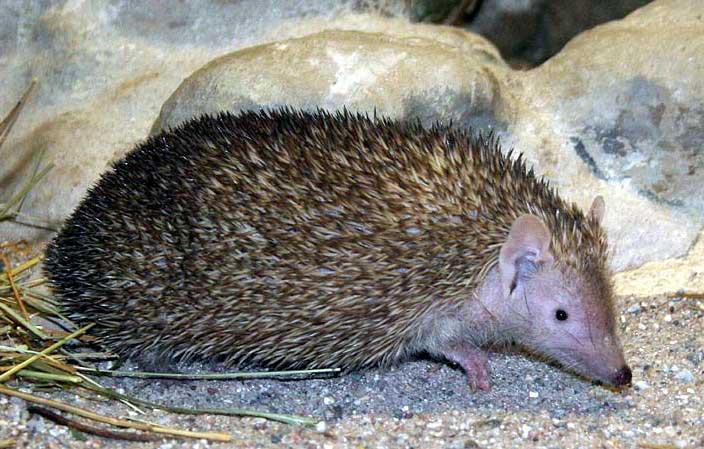Echinops telfairi (*) Cladus: Eukaryota Name Echinops telfairi Martin, 1838 References * Echinops telfairi on Mammal Species of the World.
The Lesser Hedgehog Tenrec (Echinops telfairi) is a species of mammal in the Tenrecidae family. It is the only species in the genus Echinops and is named in honor of Charles Telfair.[1]
It is endemic to Madagascar. Its natural habitats are subtropical or tropical dry forests, dry savanna, subtropical or tropical dry shrubland, and subtropical or tropical dry lowland grassland.[2] Description The lesser hedgehog tenrec is a small, stout-bodied animal similar to the hedgehog, hence the name. Their tails are short, their limbs and muzzles are of moderate length, and their ears are prominent. The entire dorsum is covered with sharp spines. Color is usually yellow buff; individuals range from near white to almost black. Head and body length is 5 to 6.8 inches. Weight is about 7 ounces. Behavior This tenrec is both terrestrial and arboreal. Shelter and hibernation It spends its daytime hours resting under a log or in a hollow tree, although trees are widely scattered in its native habitat. In hot weather, it sleeps with its body extended but otherwise lies in a curled position. It hibernates in the winter time. Diet They feed upon, as to an insectivore, insects, but sometimes other small invertebrates as well as small vertebrates, and usually forage alone, except for a mother with her young. Reproduction Breeding is known to occur in October but may depend on warm weather first arousing the animals from winter torpor and on an available food supply. The gestation period lasts 62 to 65 days. The female then gives birth to averagely 7 babies (1-10). The young are weaned at 18 to 22 days of age. References Simon and Schuster's Guide to Mammals ^ a b Bronner, Gary N.; Jenkins, Paulina D. (16 November 2005). "Order Afrosoricida (pp. 71-81)". In Wilson, Don E., and Reeder, DeeAnn M., eds. Mammal Species of the World: A Taxonomic and Geographic Reference (3rd ed.). Baltimore: Johns Hopkins University Press, 2 vols. (2142 pp.). pp. 76. ISBN 978-0-8018-8221-0. OCLC 62265494. Further reading Suárez R., Villalón A., Künzle H., Mpodozis J. (2009) "Transposition and Intermingling of Gαi2 and Gαo Afferences into Single Vomeronasal Glomeruli in the Madagascan Lesser Tenrec Echinops telfairi". PLoS ONE 4(11): e8005. doi:10.1371/journal.pone.0008005 Source: Wikipedia, Wikispecies: All text is available under the terms of the GNU Free Documentation License |
|


